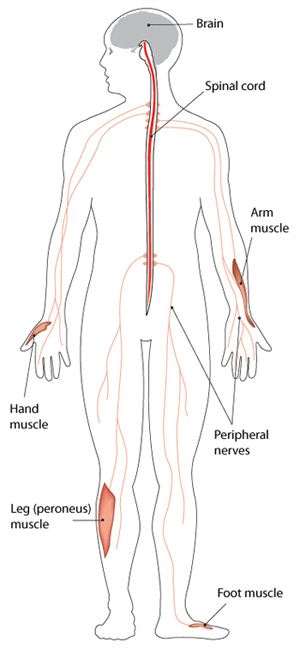Charcot-Marie-Tooth Disease (CMT)
Charcot-Marie-Tooth Disease (CMT)
 What is Charcot-Marie-Tooth disease (CMT)?
What is Charcot-Marie-Tooth disease (CMT)?
Charcot-Marie-Tooth disease (CMT) is a spectrum of nerve disorders named after the three physicians who first described it in 1886 — Jean-Martin Charcot and Pierre Marie of France and Howard Henry Tooth of the United Kingdom. The term “CMT” is regarded as being synonymous with hereditary motor sensory neuropathy (HMSN).
The overall estimated prevalence of CMT is approximately 19 instances per 100,000 people, which varies between. CMT causes damage to the peripheral nerves, which carry signals from the brain and spinal cord to the muscles and relay sensations, such as pain and touch, to the brain and spinal cord from the rest of the body. There are a number of types of CMT.
What are the symptoms of CMT?
CMT causes muscle weakness and reduction in size (atrophy), and some loss of sensation in the lower legs and feet. Sometimes the hands, wrists, and forearms are affected as well. CMT also often causes contractures (stiffened joints due to abnormal tightening of muscles and associated tissues), and sometimes, curvature of the spine (scoliosis or kyphosis).
At the severe end of the CMT spectrum, the disease can affect nerves other than those that go to and from the extremities. If the nerves that go to and from the diaphragm or intercostal (between the ribs) muscles are affected, respiratory impairment can result. For more, see Signs and Symptoms.
What causes CMT?
CMT is caused by defects in the genes that are responsible for creating and maintaining the myelin (insulating sheath around many nerves, increasing conductivity) and axonal structures.
More than 30 genes have been implicated in CMT, each one linked to a specific type (and in many cases, more than one type) of the disease.2 The vast majority of cases are attributed to mutations in just four of these genes: PMP22, MPZ, GJB1, and MFN2. 3
CMT can be inherited in several ways: autosomal dominant (through a faulty gene contributed by either parent); autosomal recessive (through a faulty gene contributed by each parent); or X-linked (through a gene on the X chromosome contributed by either parent).4,5 For more on causes and inheritance patterns in CMT, see Causes/Inheritance.
What is the progression of CMT?
Depending on the type of CMT, onset can be from birth to adulthood, and progression is typically slow. CMT usually isn't life-threatening, and it rarely affects the brain.
What is the status of research on CMT?
CMT research is focused on exploring the effects of defects in genes related to the peripheral nervous system and devising strategies to combat these effects.
Download our Charcot-Marie-Tooth disease (CMT) Fact Sheet
References
- Understanding Neuromuscular Disease Care. IQVIA Institute. Parsippany, NJ. (2018).
- Klein, C. J., Duan, X. & Shy, M. E. Inherited neuropathies: Clinical overview and update. Muscle and Nerve (2013). doi:10.1002/mus.23775
- Saporta, A. S. D. et al. Charcot-marie-tooth disease subtypes and genetic testing strategies. Ann. Neurol. (2011). doi:10.1002/ana.22166
- Hahn, A. F., Brown, W. F., Koopman, W. J. & Feasby, T. E. X-linked dominant hereditary motor and sensory neuropathy. Brain (1990). doi:10.1093/brain/113.5.1511
- Tazir, M., Bellatache, M., Nouioua, S. & Vallat, J. M. Autosomal recessive Charcot-Marie-Tooth disease: From genes to phenotypes. Journal of the Peripheral Nervous System (2013). doi:10.1111/jns5.12026

